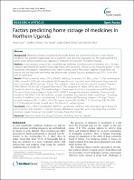| dc.contributor.author | Ocan, Moses. | |
| dc.contributor.author | Bbosa, Godfrey | |
| dc.contributor.author | Waako, Paul | |
| dc.contributor.author | Ogwal-Okeng, Jasper | |
| dc.contributor.author | Obua, Celestino | |
| dc.date.accessioned | 2019-10-30T16:30:30Z | |
| dc.date.available | 2019-10-30T16:30:30Z | |
| dc.date.issued | 2014 | |
| dc.identifier.citation | Ocan, M., Bbosa, G. S., Waako, P., Ogwal-Okeng, J., & Obua, C. (2014). Factors predicting home storage of medicines in Northern Uganda. BMC Public Health, 14(1), 650. | en_US |
| dc.identifier.uri | https://hdl.handle.net/123456789/75 | |
| dc.description.abstract | Background: Medicines are kept in households Worldwide for first aid, treatment of chronic or acute disease
conditions. This promotes inappropriate use of medicines and hence the associated risks. The study explored the
factors which predict availability and utilization of medicines in households of Northern Uganda.
Method: A cross sectional survey of 892 households was performed from November-to-December 2012. Five data
collectors administered the questionnaires, respondents were requested to bring out any medicines present in their
households. Demographic characteristics, drug name, quantity, source, formulation, legibility of drug labels and
reasons why the medicines were being kept at home was collected. Data was analyzed using STATA 12.0 at 95%
level of significance.
Results: Of the households visited, 35.1% (313/892) had drugs. Paracetamol (11.8%), coartem (11.3%), cotrimoxazole
(10%), amoxicillin (9.2%) and metronidazole (8.2%) were the major medicines found. Antibacterial drugs were the
most commonly (40.1%) kept type of drugs. The medicines present in households were for on-going treatment
(48%); ‘leftover’ (30.5%) and anticipated future use (21.6%). Symptoms of malaria (34.1%) were common in
households which had drugs. The medicines kept in homes were mainly from the private sector 60.5% (497/821).
The rate of home drug storage was higher 85.3% (267/313) amongst the educated individuals. There was high
prevalence 76% (238/313) of self-medication among respondents in households which stored drugs. The average
number of medicines in each household was 6 ± 5 with majority (68.1%) having between 1–10 drugs. Previous
successful treatment (OR: 1.3; 95% CI: 0.95-1.77), regular income (OR: 1.8; 95% CI: 1.2-2.6) and sex (OR: 0.63; 95%
CI: 0.5-0.9) predicted storage of medicines in households in northern Uganda.
Conclusion: Over a third of households in Northern Uganda store medicines with antibacterial agents being the
most common. Self-medication is common among individuals in households which keep drugs. Past successful
treatment, regular income and sex predict community home drug storage. | en_US |
| dc.language.iso | en | en_US |
| dc.publisher | BioMed Central | en_US |
| dc.subject | Medicines | en_US |
| dc.subject | Home drug storage | en_US |
| dc.subject | Northern Uganda | en_US |
| dc.subject | Uganda | en_US |
| dc.title | Factors predicting home storage of medicines in Northern Uganda | en_US |
| dc.type | Article | en_US |

